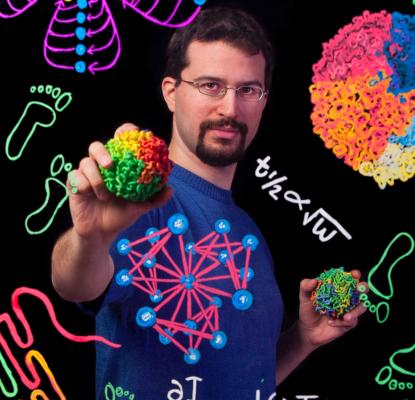Erez Lieberman-Aiden
Erez Lieberman-Aiden’s voracious appetite for science and math began as a child growing up in Brooklyn, New York. His father encouraged him to explore a wide array of projects in order to be well-rounded, a goal that Lieberman-Aiden has carried with him into his adult life. Over the past decade, Lieberman-Aiden has proven himself a true “Renaissance man.”
As an undergraduate at Princeton University, Lieberman-Aiden simultaneously studied mathematics, physics, and philosophy. He has since created innovations that span linguistics, mathematics, engineering, and molecular biology, and he has excelled in the arts. Lieberman-Aiden’s inventions prove diverse, yet all carry the potential to make a transformative societal impact.
His latest invention, developed with Nynke van Berkum and their advisors, Eric Lander and Job Dekker, is a ground-breaking method for three dimensional genome sequencing called “Hi-C”. Lieberman-Aiden hopes that Hi-C will help scientists understand how genes are turned on and off inside the cell and shed light on diseases like cancer in fundamentally new ways. In addition to honing his skills in molecular biology, Lieberman-Aiden has shown a knack for engineering with his invention of the iShoe, a sensor-laden insole that provides computational information to assist an elderly person’s sense of balance, reducing the risk of broken hips.
A speaker of English, Hebrew, and Hungarian, as well as a reader of several dialects of Aramaic, Lieberman-Aiden’s passion for language and culture has carried over into his innovative work on theoretical sciences and linguistics. Most notably, he and collaborator Jean-Baptiste Michel co-authored a paper on the emergence of linguistic rules over the centuries, clearly demonstrating the effects of natural selection. The piece has been hailed as a scientific literary masterpiece and graced the cover of Nature in 2007. Additionally, Lieberman-Aiden worked with Martin Nowak and Christoph Hauert to discover evolutionary graph theory, a renowned approach to population genetics that explores the effects of structure on the evolution of a population.
Lieberman-Aiden’s research is supported by fellowships from the Hertz Foundation, National Defense Science and Engineering, and National Science Foundation. He also mentors college students at the Research Opportunities in Mathematical Evolution program at Harvard, all while earning a Ph.D. in Applied Mathematics at Harvard and in the Division of Health Sciences and Technology at Harvard and MIT.
When not pursuing his passion for the sciences, Lieberman-Aiden is a skilled and prolific modern artist and writer. As part of a multi-year collaboration with Nicholas Kahn and Richard Selesnick, his work appeared in galleries across the United States and Europe; the trio co-authored two works of modern art fiction, The Apollo Prophecies and City of Salt. The latter was named one of PhotoEye's “Best Books of 2006.”
Lieberman-Aiden can also add humanitarian to his long list of achievements. He and wife, Dr. Aviva Presser-Aiden, an MIT alumna and 2009 Lemelson-MIT Student Prize finalist, started a program called “Bears Without Borders.” This international NGO raises funds and hires local artisans in developing countries to produce stuffed animals which are distrubuted within the communities to chronically ill children and orphans. The couple’s efforts have brightened the lives of children in twenty countries across the globe.


